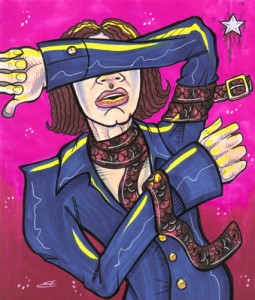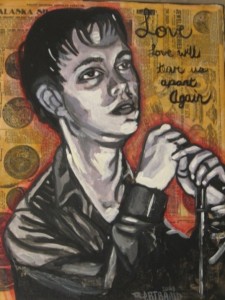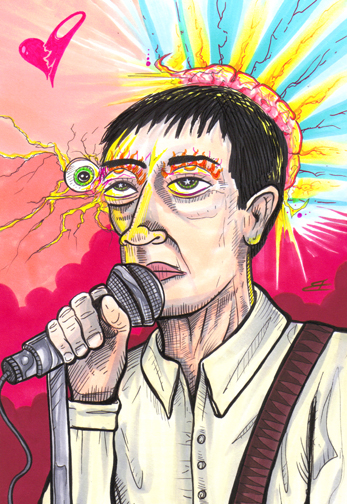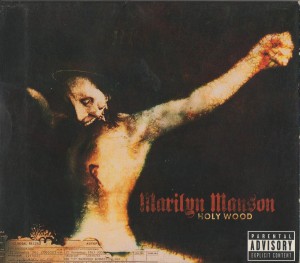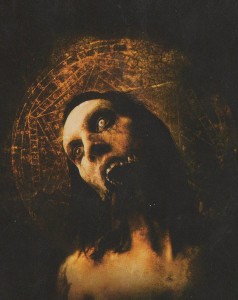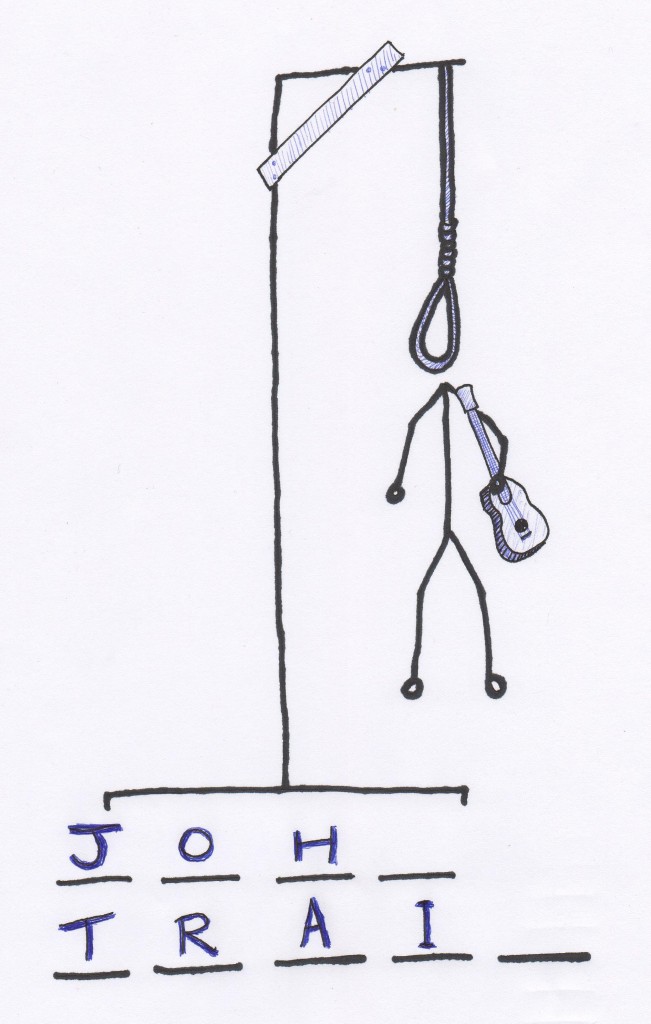If there is such a thing as too much pussy, then Michael Hutchence must have gotten it. Remember the topless girl with the stunning green eyes from Chris Isaak’s “Wicked Games” video? Hutchence hit that. Or the ghostly girl with the ruby lips singing in Nick Cave’s “Where the Wild Roses Grow”? Hutchence hit that, too. Television interviewers, supermodels, pop starlets, and an endless stream of groupies playfully dubbed “INXS-ories”—Michael took primal lust to extremes that the average porn addict couldn’t approach vicariously.
Michael was on that sweet love-makin’ sadomasochist mack daddy on crack tip. He tied them up and tortured them with pleasure. He snorted drugs off their toe-nails and tongued them down til they wanted to die. He probably ate grapes off their butt cheeks. They don’t call it a “Hutchence steamer” for nothin’. Described by those who loved him as warm and charming, the smooth-talking Australian had a habit of charming his friend’s lovers into a warm bed. Just a day in the life of a dirty rock star, until the paparazzi caught Hutchence doing the wrong man dirty.
Bob Geldof was a saint, canonized by the media and knighted by the Queen. From 1985 on, he could do no wrong. That year he organized Live Aid, a multi-venue benefit concert to relieve famine-stricken Ethiopia, which was performed in London and Philadelphia and broadcast across the planet. Bob and his wife-to-be sat next to Prince Charles and Princess Diana in Wembley Stadium while nearly two billion viewers received his all-star pop showcase via satellite, including Bob Dylan and Queen, along with the crushing guilt that comes with eating a burger while Africans starve to death. The event raised upward of £50 million that day, much of which inadvertently went to fund Ethiopia’s genocidal Communist dictator Mingitsu Haile Miriam and his guerilla army. All saints must suffer, and such an ironic misappropriation must have ground Geldof’s gears, but not nearly as bad as the humiliating and highly publicized cuckoldry inflicted by his reckless wife ten years later.
Bob began romancing Paula Yates when she was barely eighteen, back when she was just a little fan girl following his band, the Boomtown Rats. Thinking himself to be older and wiser—eight years to be exact—he struggled to keep her wild oats out of the feeding troughs of the rich and famous. After their protracted courtship resulted in a daughter, they were finally wed in a $50 Las Vegas Marry-Mart. Paula would bear Bob three daughters in all, naming them Fifi, Peaches, and Pixie. And that was before she started getting high.
Aside from authoring self-help books on motherhood and posing for Penthouse, Paula’s greatest claim to fame was as a UK music television personality. She was highly regarded for her engaging interviews with pop stars on the ascent. It’s only natural that she’d develop a little crush here and there.
Michael Hutchence’s handsome photograph suddenly appeared on the Geldof family refrigerator after Paula interviewed him on The Tube in 1985. But Bob was a trusting husband. He kept his cool. Nine years later, Bob’s suspicions—and the rest of the world’s—were finally roused during Paula’s sultry “on the bed” interview with Hutchence for The Big Breakfast. The jealousy drove Bob bonkers, and after Paula indulged a few too many late nights out, he confronted Michael at a party, telling the star to leave his wife alone. Paula denied everything when she found out. She even insisted that Bob call Hutchence and apologize, which Bob did reluctantly, his gloomy penis staring down at his feet.
The chemistry between Michael and Paula couldn’t have been more obvious, but it took front page photos of the cheating couple leaving the Halkin Hotel together to tear the wool from Bob’s bleary eyes. It was Sunday morning, February 11, 1995, and Geldof was pissed off. Two and a half years later, Michael was found naked and dead.
It had been a wild ride up to that fateful night. While INXS’ music may have been somewhat bland and forgettable, Michael’s performances exploded with such slick sexual savagery that every guy in the audience wanted to be him and every girl wanted to be with him—hence the Hutchence curse. He also wrote a poignant pop track addressing the nasty business of human nature called “Devil Inside,” so stop calling him a mediocre merry-maker, you Aussie-hating asshole. The international market may only have loved Hutchence passionately for the album Kick, but Australia remained loyal to their star while the rest of the world jeered.
The whole business with Bob and Paula had been nasty from the start. One alpha altruist, two chatty cheaters, three cartoon-named babies, and an army of tabloid photographers with film to spare. It’s hard to imagine what it must have been like for Michael and Paula to have their sordid lives documented and devoured by the yellow press and their insatiable public, from that first hotel headline to the Geldofs’ bizarre divorce proceedings (which left Paula and Michael living in Bob’s house, and Bob living in Michael’s old apartment) to the birth of Michael and Paula’s daughter (named Heavenly Hiraani Tiger Lily Hutchence—no kidding) to the police investigations after their nanny found opium in the crazy couple’s house to Paula’s sorry suicide attempts to that iconic Brit Awards moment in ’96 when Michael presented the Best Band award to Noel Gallagher, who sneered back, “I’d just like to say that fucking has-beens shouldn’t be giving awards to gonna-bes!” It’s no wonder Michael was always punching out paparazzi photographers—it must have been the only enjoyable pastime left to a man numbed to life’s little pleasures.
A random encounter in 1992, years before all the trouble started, may shed some light on Michael’s twisted peanut. He had been walking in Amsterdam with his supermodel girlfriend on his arm, and stepped in front of a taxi. The cabbie had clearly been having a bad day when suddenly this arrogant, swaggering rock star type walks in front of his cab at a leisurely pace, fucking up the driver’s schedule and sporting a highlighted perm to boot. The cabbie snapped, got out of his taxi, and shoved Michael to the sidewalk. Michael cracked his head on the concrete, causing minor brain damage. In the blink of an eye, the natural sensualist had lost his sense of taste and smell. Perhaps, as is common in such cases, he homed in on other senses to compensate.
It was November 22, 1997—the 35th deathday of JFK—and Michael was having a distressing night in Australia. His rock n’ roll rollercoaster had begun in Sydney’s dive bars two decades before, taken him around the world in a death-defying spiral, and left him wrecked in a Ritz Carlton hotel room in the same city on the eve of a small venue tour, bringing him full circle. Besides partying with a local couple, he’d been on the phone all night, feeling sorry for himself to Paula, chatting with a new lover in LA, and going off on Geldoff about child custody issues. By early morning, Hutchence was lonely and fucked up. He’d consumed a cocktail that included cocaine, champagne, Valium, and Prozac, but that’s not what killed him.
Michael was the type who needed excitement to calm his nerves. He could have called a hooker that night, but how boring. Maybe he could call two—twice as boring. He could go down to the street and start a fist fight, or arrange to go skydiving, or maybe just pick the phone back up and prank call at random. Boooriiing.
A belt can be used for a lot of things. Put it through your belt loops, and your trousers won’t fall down to your ankles. Double it over, and you’ve got a kinky disciplinary tool. Tighten it above your elbow, and you’ve got the perfect tie-off for a soothing shot of heroin. Slip it around your neck, and suddenly bold new horizons open up.
Michael’s body was discovered in his hotel room by a dumbfounded maid. His leather belt had been tightened around his neck and tied to the door handle. He was as naked as Adam in Eden, but not nearly so innocent. According to Hutchence’s brother, forensic investigators found small amounts of semen on Michael’s body, indicating an auto-erotic asphyxiation sesh gone horribly wrong. Despite the coroner’s verdict of suicide, there is every reason to believe that out of desperation for one sweet moment of relief, Michael decided to choke himself while tugging one out, then suddenly lost control of the enterprise.
Earlier in the day he’d told an interviewer for Adelaide’s Sunday Mail:
“The press, especially in England, makes a construct of a human, and then they either do two things with that person. They make them beyond human, or they dehumanize them…
“See, it’s against the law to destroy Jews, blacks, people for religious causes. The law and Parliament have stopped discrimination like that. All we have left is celebrity, and every society has to kick a dog, it’s a fact. Someone to raise and someone to burn. It’s human nature…”
After gorging oneself on the all-you-can-eat buffet presented to superstars, the only thing left to do is eat the silverware and flash a broken smile to the public. That strangled gurgle heard around the world was Michael saying, “Cheese!”
© 2011 Joseph Allen
INXS — “Devil Inside”
1987
If there is such a thing as too much pussy, then Michael Hutchence must have gotten it. Remember the topless girl with the stunning green eyes from Chris Isaak’s “Wicked Games” video? Hutchence hit that. Or the ghostly girl with the ruby lips singing in Nick Cave’s “Where the Wild Roses Grow”? Hutchence hit that, too. Television interviewers, supermodels, pop starlets, and an endless stream of groupies playfully dubbed “INXS-ories”—Michael took the satisfaction of primal lust to extremes that the average man couldn’t approach vicariously in porno-stacked warehouse and a pack of bubblegum. Michael was on that sweet love-makin’ sadomasochist mack daddy on crack tip. He tied them up and tortured them with pleasure. He snorted drugs off their toe-nails and tongued them down til they wanted to die. He ate food out of their butt cracks. And they don’t call it a “Hutchence steamer” for nothin’. Described by those who loved him as warm and charming, the smooth-talking Australian had a habit of charming his friend’s lovers into a warm bed. Just a day in the life of a dirty rock star, until the paparazzi caught Hutchence doing the wrong man dirty.
Bob Geldof was a saint, canonized by the media and knighted by the Queen. From 1985 on, he could do no wrong. That year he organized Live Aid, a multi-venue benefit concert to relieve famine-stricken Ethiopia, which was played in London and Philadelphia and broadcast across the planet. Bob and his wife-to-be sat next to Prince Charles and Princess Di in Wembley Stadium while nearly two billion viewers received his all-star pop showcase via satellite, including Bob Dylan and Queen, along with the crushing guilt that comes with eating a burger while Africans starve to death. The event raised upward of £50 million that day, much of which inadvertantly went to fund Ethiopia’s genocidal Communist dictator Mingitsu Haile Miriam and his guerilla army. All saints must suffer, and such an ironic misappropriation must have ground Geldof’s gears . But not nearly as bad as the humiliating and highly publicized cuckolding inflicted by his reckless wife ten years later.
Bob began romancing Paula Yates when she was barely eighteen, back when she was just a little fan girl following his band, the Boomtown Rats. Thinking himself to be older and wiser—eight years to be exact—he struggled to keep her wild oats out of the feeding troughs of the rich and famous. After their protracted courtship resulted in a daughter, they were finally wed in a $50 Las Vegas Marry-Mart. Paula would bear Bob three daughters in all, naming them Fifi, Peaches, and Pixie. And that was before she started getting high.
Aside from authoring self-help books on motherhood and posing for Penthouse, Paula’s greatest claim to fame was as a UK music television personality. She was highly regarded for her engaging interviews with pop stars on the ascent. It’s only natural that she’d develop a little crush or two.
Michael Hutchence’s handsome photograph suddenly appeared on the Geldof family refrigerator after Paula interviewed him on The Tube in 1985. But Bob was a trusting husband. He kept his cool. Nine years later, Bob’s suspicions—and the rest of the world’s—were finally roused during Paula’s “on the bed” interview with Hutchence for The Big Breakfast. The jealousy drove Bob bonkers, and after Paula indulged a few too many late nights out, he confronted Michael at a party, telling the star to leave his wife alone. Paula denied everything when she found out. She even insisted that Bob call Hutchence and apologize, which Bob did reluctantly, his gloomy penis staring down at his feet.
The chemistry between Michael and Paula couldn’t have been more obvious, but it took front page photos of the cheating couple leaving the Halkin Hotel together to tear the wool from Bob’s bleary eyes. It was Sunday morning, February 11, 1995, and Geldof was pissed off. Two and a half years later, Michael was found naked and dead.
It had been a wild ride up to that fateful night. While the music may have been somewhat bland and forgettable, Michael’s performances with INXS exploded with such slick sexual savagery, every guy in the audience wanted to be him and every girl wanted to be with him, hence the Hutchence curse. He also wrote a poignant pop track addressing the nasty business of human nature, “The Devil Inside,” and that has to count for something. So stop calling him a mediocre merry-maker. The international market only loved Hutchence passionately for the album Kick, but Australia remained loyal to him to the bitter end.
The whole business with Bob and Paula had been nasty from the start. One altruistic alpha male, two chatty cheaters, three cartoon-named babies, and an army of tabloid photographers with film to spare. It’s hard to imagine what it must have been like for Michael and Paula to have their sordid lives documented and devoured by the yellow press and their insatiable public, from their first front page leaving the hotel together to the Geldof’s bizarre divorce proceedings (which left Paula with Bob’s house, and Bob living in Michael’s old apartment) to the birth of Michael and Paula’s daughter (named Heavenly Hiraani Tiger Lily Hutchence—no kidding) to the police investigations after their nanny found opium in the crazy couple’s house to Paula’s sorry suicide attempts to that iconic Brit Awards moment when Michael presented the Best Band award to Noel Gallagher, who sneered back, “I’d just like to say that fucking has-beens shouldn’t be giving awards to gonna-bes!” It’s no wonder Michael was always punching out paparrazi photographers—it must have been the only enjoyable pastime left to a man numb to life’s little pleasures.
A random encounter in 1992, years before all the trouble started, may shed some light on Michael’s twisted peanut. He had been walking in Amsterdam with his supermodel girlfriend on his arm, and stepped in front of a taxi. The cabbie had clearly been having a bad day, when suddenly this arrogant, swaggering rock star type walks in front of his cab at a leisurely pace, fucking up the driver’s schedule and sporting a highlighted perm to boot. The cabbie snapped, got out of his taxi, and shoved Michael to the sidewalk. Michael cracked his head on the concrete, causing minor brain damage. In the blink of an eye, the natural born sensualist had lost his sense of taste and smell. Perhaps, as is common in such cases, he homed in on other senses to compensate.
It was November 22, 1997—the 35th deathday of JFK—and Michael was having a distressing night in Australia. His rock n’ roll rollercoaster had begun in Sydney’s dive bars two decades before, took him around the world in a death-defying spiral, and left him wrecked in a Ritz Carlton hotel room in the same city on the eve of a come-back tour, bringing him full circle. Between partying with a local couple, he’d been on the phone all night, feeling sorry for himself with Paula, chatting with a new lover in LA, and going off on Geldoff about his refusal to allow his daughters to go on vacation with Michael and Paula. By early morning, Hutchence was lonely and fucked up. He’d consumed a cocktail that included cocaine, champagne, Valium, and Prozac, but that’s not what killed him.
Earlier in the day he’d told Adelaide’s Sunday Mail:
“The press, especially in England, makes a construct of a human, and then they either do two things with that person. They make them beyond human, or they dehumanize them…
“See, it’s against the law to destroy Jews, blacks, people for religious causes. The law and Paliament have stopped discrimination like that. All we have left is celebrity, and every society has to kick a dog, it’s a fact. Someone to raise and someone to burn. It’s human nature…”
A belt can be used for a lot of things. Put it through your belt loops, and your pants won’t fall down to your ankles. Double it over, and you’ve got a kinky disciplinary tool. Tighten it above your elbow, and you’ve got the perfect tie-off for a soothing shot of heroin. Slip it around your neck, and suddenly bold new horizons open up.
Michael’s body was discovered in his hotel room by a dumbfounded maid. His leather belt had been tightened around his neck and tied to the door handle. He was naked as Adam, but not nearly so innocent. According to Hutchence’s brother, forensic investigators found small amounts of semen on Michael’s body, indicating an auto-erotic asphyxiation sesh gone horribly wrong. Despite the coroner’s verdict of suicide, there is every reason to believe that out of desperation for one sweet moment of relief, Michael decided to choke himself while he tugged one out, then suddenly lost control of the enterprise.
After gorging oneself on life’s sensual buffet for so long, the only thing left to do is eat the silverware and smile at the.world with broken teeth.
